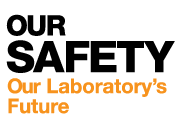



— From Interim Lab Director Paul Alivisatos
We recently received the results of the HSS inspection of environmental, safety, and health programs at Berkeley Lab conducted in January and February. In its final report, the DOE HSS team praised the Lab for "...fostering a ‘learning organization’ that embraces continuous improvement in safety."
The Safety Inspection report points out areas for improvement, and a corrective action plan must be developed to address these. The HSS Finding Teams have been working hard to perform the causal analysis, identify extent of condition, and develop the corrective actions, and have developed a summary outlining the root causes and proposed corrective actions.
In support of fostering open communication and continuous improvement, I encourage you to review these outlines and provide your input to the HSS Steering Committee by May 8. It is important to share our thoughts and ideas during this critical period before the final corrective action plan is submitted to DOE Headquarters for approval on June 5.
 Research: Invisibility Cloak Blurs Lines Between Magic and Science
Research: Invisibility Cloak Blurs Lines Between Magic and Science Never mind Harry Potter, researchers at Berkeley Lab have made an invisibility cloak of their own. A team led by Xiang Zhang of the Materials Sciences Division has taken a major step toward a true invisibility device with the creation of a carpet cloak from nanostructured silicon that conceals the presence of objects placed under it from optical detection. This new cloak suggests that true invisibility materials are within reach. More>
 [New York Times] Photovoltaic cells are already a familiar sight on rooftops. But one day, miniature cells may also be found in more unconventional places: power-generating windows, car sunroofs or even awnings. The new technology is the work of a researcher and his colleagues who developed a way to print ultrathin, semitransparent and flexible cells on plastic, cloth and other materials. Their approach offers a unique strategy for making highly efficient, flexible solar cells for large-scale production, said Berkeley Lab materials scientist Ali Javey, who co-wrote a review of the work for the journal Nature Materials. More>
[New York Times] Photovoltaic cells are already a familiar sight on rooftops. But one day, miniature cells may also be found in more unconventional places: power-generating windows, car sunroofs or even awnings. The new technology is the work of a researcher and his colleagues who developed a way to print ultrathin, semitransparent and flexible cells on plastic, cloth and other materials. Their approach offers a unique strategy for making highly efficient, flexible solar cells for large-scale production, said Berkeley Lab materials scientist Ali Javey, who co-wrote a review of the work for the journal Nature Materials. More>
 [Physorg.com] How safe is the air we breathe inside our homes and workplaces? Contaminants are many and varied, including off-gassing of toxic chemicals called Volatile Organic Compounds (VOCs) from building materials and furniture; carbon monoxide; radon; spores and mycotoxins from mold; pesticides; allergens from pets, insects, dust mites and other sources, and tobacco smoke. The cost of ignoring this issue is steep: a recent study by William Fisk, with Berkeley Lab’s Environmental Energy Technologies Division, concluded that losses due to sick leave, medical treatment, and lowered productivity may be as high as $48 billion annually in the U.S. More>
[Physorg.com] How safe is the air we breathe inside our homes and workplaces? Contaminants are many and varied, including off-gassing of toxic chemicals called Volatile Organic Compounds (VOCs) from building materials and furniture; carbon monoxide; radon; spores and mycotoxins from mold; pesticides; allergens from pets, insects, dust mites and other sources, and tobacco smoke. The cost of ignoring this issue is steep: a recent study by William Fisk, with Berkeley Lab’s Environmental Energy Technologies Division, concluded that losses due to sick leave, medical treatment, and lowered productivity may be as high as $48 billion annually in the U.S. More>
 Meet Ben Ortega, group leader of the Lab’s International Researchers and Scholars Office (Human Resources). With the Lab since 1999, Ortega says the best part of his job is dealing with complex legal problems and meeting people from around the world. When not at the Lab, Ortega can often be found on a local stage acting in theater productions. “I got into acting by accident,” explains Ortega. “The owner of a theatre company in Washington D.C. saw my stand-up comedy routine one night, and offered me a role in his next play. I said yes and fell head over heels in love with theatre.” That was back in 1996, and he has been performing ever since. His latest project is “Frankie and Johnny in the Clair de Lune” at the EXIT Theatre in San Francisco, running today through May 24.
Meet Ben Ortega, group leader of the Lab’s International Researchers and Scholars Office (Human Resources). With the Lab since 1999, Ortega says the best part of his job is dealing with complex legal problems and meeting people from around the world. When not at the Lab, Ortega can often be found on a local stage acting in theater productions. “I got into acting by accident,” explains Ortega. “The owner of a theatre company in Washington D.C. saw my stand-up comedy routine one night, and offered me a role in his next play. I said yes and fell head over heels in love with theatre.” That was back in 1996, and he has been performing ever since. His latest project is “Frankie and Johnny in the Clair de Lune” at the EXIT Theatre in San Francisco, running today through May 24.
 The Lab’s Health Care Facilitator wants to remind employees that May is National High Blood Pressure Month. High blood pressure is often called the “silent killer” because it usually has no noticeable warning signs or symptoms until other serious problems arise. High blood pressure is a major risk factor for heart disease, the leading cause of death in the United States. High blood pressure can be treated with both lifestyle modifications, and if needed, medications. It is important to exercise, eat a healthy diet, and limit the intake of alcohol.
The Lab’s Health Care Facilitator wants to remind employees that May is National High Blood Pressure Month. High blood pressure is often called the “silent killer” because it usually has no noticeable warning signs or symptoms until other serious problems arise. High blood pressure is a major risk factor for heart disease, the leading cause of death in the United States. High blood pressure can be treated with both lifestyle modifications, and if needed, medications. It is important to exercise, eat a healthy diet, and limit the intake of alcohol.
Today at Berkeley Lab is produced by Public Affairs' Communications Department